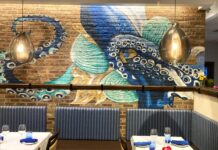We’re going to hazard a guess that Storming Crab (1360 Veterans Parkway in Clarksville IN) was the first local example of the quasi-Asian-infused Cajun boiled seafood restaurant, exemplar of an American coastal trend creeping into the heartland from places like Louisiana, Houston TX and Southern California.
This much is clear: Louisville may be getting as many as three more thematically similar Cajun/boiled seafood restaurants.
One needn’t consult Wikipedia to know that seafood boils are common to the seashore, nearest regionally preferred fish and crustaceans. If the notion of America as melting pot means anything at all, a logical corollary to these traditions is the possibility — indeed, the likelihood — that newly arrived immigrants will add their own twist to the tale.
After all, the “Cajuns” themselves were French Canadians relocated to Louisiana. Here is an account of Viet-Cajun crawfish.
When exactly did Vietnamese-owned Cajun crawfish eateries become Vietnamese-Cajun crawfish eateries? Somewhere along the westward road from Louisiana to California, Vietnamese cooks began tinkering with the time-honored recipe: rather than simply boiling the crawfish in Cajun spices, they add a step of immediately cooling boiled crawfish and then tossing the mudbugs in a butter-based sauce that may also include garlic, onions, peppers, orange wedges, and lemongrass. The result is a succulent inside of crawfish meat and broth-like sauce amplified in flavor by the chunks of bright seasonings and mouth-searing spices encasing the shell. And that’s not to mention the dipping sauce called muối tiêu chanh, which translates literally to salt, pepper, and lime.
And, a snippet from a review of the Boiling Crab in Los Angeles.
Those who flock to these restaurants trade concerns about authenticity and heritage for passion toward new and exciting tastes. Eating messy seafood out of the bag or off the tray with nothing but a bib and a roll of paper towels as a buffer is exciting, regardless of cultural background. Vietnamese-Cajun food is a promising message that immigrants to the United States do not have to sacrifice their heritage to be successful, and that, in fact, unique cultural foods can be much more successful than monotonous American classics. Like tacos made with ground beef and cheddar cheese, Vietnamese immigrants recreated their seafood with the swamp crustaceans abundantly found in their new homes, creating a new style of food in the process.
In an effort to make this long story shorter, and avoiding further comment about potential cultural influences (as fascinating as these may be), just let it suffice to say that there’ll be a few more eatery options coming to Louisville where you can get boiled, messy and stuffed to the gills.


























